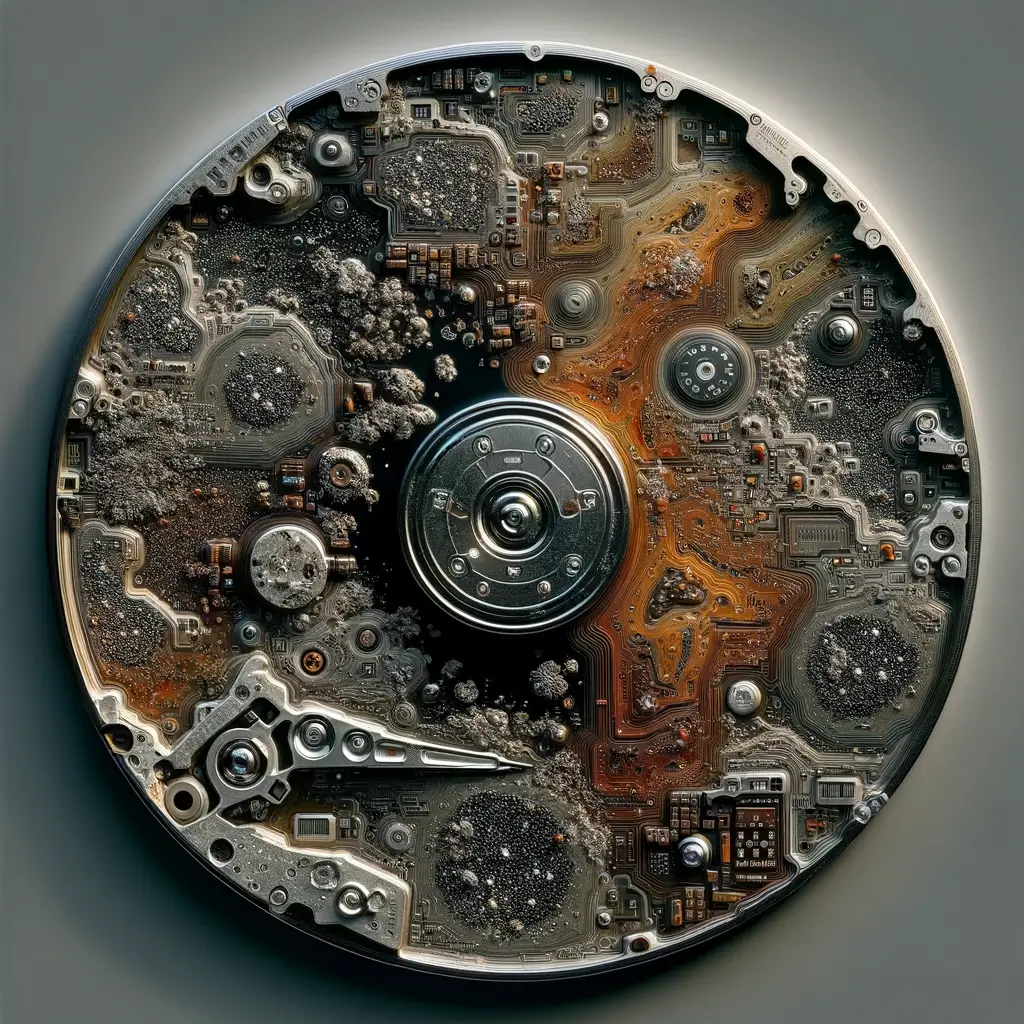What is Bit Rot?
 Bit rot, also known as data decay, data degradation, data deterioration, or data rot, refers to the gradual corruption of digital information over time leading to partial or complete loss of data. It occurs when individual bits, the fundamental units of data storage, flip from their intended state (0 or 1) to the opposite, leading to errors within the stored data. This silent process can go unnoticed for extended periods until crucial information becomes inaccessible or unusable.
Bit rot, also known as data decay, data degradation, data deterioration, or data rot, refers to the gradual corruption of digital information over time leading to partial or complete loss of data. It occurs when individual bits, the fundamental units of data storage, flip from their intended state (0 or 1) to the opposite, leading to errors within the stored data. This silent process can go unnoticed for extended periods until crucial information becomes inaccessible or unusable.
There are several misconceptions about bit rot. For example, some believe it only affects old data or certain types of media. However, bit rot can affect any digital storage medium and can occur regardless of the data’s age.
What Causes Bit Rot?
Several factors contribute to bit rot, categorized into three main areas:
Physical Degradation:
- Ageing Storage Media: As storage devices age, their physical components naturally degrade, increasing the likelihood of bit flips.
- Temperature Fluctuations: Extreme temperatures or frequent temperature variations can accelerate physical degradation and contribute to bit rot.
Environmental Factors:
- Cosmic Rays: High-energy particles from outer space, known as cosmic rays, can strike storage media and cause bit flips, even if the device is well-protected.
Manufacturing Defects:
- Faulty Memory Cells: In rare instances, manufacturing defects can lead to faulty memory cells within storage devices, making them susceptible to bit errors and contributing to bit rot.
Bit Rot in Different Storage Media

Hard Disk Drives (HDDs)
Bit rot in HDDs primarily occurs due to the physical degradation of the magnetic recording layer on the platters. Additionally, mechanical wear and tear can further increase the risk of bit errors.
Solid State Drives (SSDs)
In SSDs, the main culprit behind bit rotting is charge leakage from storage cells. Over time, electrons stored in the cells can leak, leading to a loss of data integrity and potential bit flips.
Optical Media (CDs, DVDs, and Blu-ray Disks)
Optical media can suffer from bit rot due to physical degradation of the disk material, such as delamination or scratches.
Tape Storage and Other Archival Media
Tape media is prone to bit rotting through adhesive breakdown and magnetic degradation, which can be accelerated by poor storage conditions.
Business and IT Impact of Bit Rot
The consequences of bit rot can be far-reaching for businesses and IT teams:
Data Loss and Corruption
Undetected bit rot can lead to the permanent loss or corruption of critical data, including documents, financial records, customer information, and intellectual property. This can have significant financial repercussions and legal implications.
System Malfunctions and Downtime
Corrupted data due to bit rot can cause unexpected system errors, application crashes, and system instability. This leads to operational disruptions, downtime, and lost productivity, impacting both business efficiency and customer satisfaction.
Reputational Damage
Data loss due to bit rot can erode trust and damage a business’s reputation. Customers and partners may lose confidence in the organization’s ability to safeguard its data, leading to potential business setbacks and compliance violations.
How to Detect Bit Rot
The silent nature of bit rot makes it challenging to detect its presence proactively. However, several methods can help identify potential issues.
Challenges of Identifying Bit Rot
Bit rot often goes unnoticed because:
- It occurs gradually and doesn’t always manifest immediately.
- Corrupted data may not always lead to obvious errors or system failures.
- Businesses may not have adequate data integrity monitoring practices in place.
Methods for Detecting Bit Rot
- Data Scrubbing: This process systematically reads and checks stored data against a previously stored checksum, a unique digital fingerprint. Any discrepancies indicate potential bit errors, allowing for corrective action before significant damage occurs.
- Parity Checks & ECCs: These techniques, implemented during data transfer and storage, automatically detect and correct errors, including those caused by bit rot. Parity checks use an extra bit to verify data integrity, while Error-Correcting Codes (ECCs) are more advanced algorithms that can not only detect but also correct a limited number of errors.
- SMART Monitoring: This technology built into modern storage devices monitors their health and performance. By keeping an eye on SMART data, you can identify potential issues like excessive errors or weak sectors, which could be early indicators of bit rot or other storage problems.
- Log Monitoring & Alerts: System logs and event notifications can be configured to monitor for specific error codes or events that may indicate potential bit rot. Setting up alerts based on relevant log entries helps you get notified promptly of potential issues and take necessary actions before significant data loss occurs.
How to Prevent Bit Rot: 7 Best Practices
#1 Choosing Reliable Storage Media
 Opt for high-grade storage devices: Select storage devices from reputable brands known for their reliability and durability. Consider factors like warranty periods, error correction capabilities, and mean time to data loss (MTDL) when making your selection.
Opt for high-grade storage devices: Select storage devices from reputable brands known for their reliability and durability. Consider factors like warranty periods, error correction capabilities, and mean time to data loss (MTDL) when making your selection.
Solid-State Drives (SSDs) vs. Hard Disk Drives (HDDs): While both are susceptible to bit rot, SSDs generally exhibit lower bit error rates compared to HDDs due to the absence of moving parts. However, SSDs have their own limitations, such as potential endurance issues and write amplification. Choose the storage technology that best suits your specific needs and budget.
#2 Optimizing Storage Conditions
Maintain consistent temperature and humidity: Store your data in controlled environments with stable temperature and humidity levels. Avoid extreme temperatures and rapid fluctuations, which can accelerate physical degradation and increase the risk of bit rot. Industry standards recommend a temperature range of 15°C to 25°C (59°F to 77°F) and a relative humidity level between 30% and 50%.
Minimize exposure to physical elements: Protect your storage devices from dust, moisture, and vibrations. These environmental factors can contribute to physical wear and tear, potentially increasing the susceptibility to bit rot.
#3 Regular Data Migration
Transfer data to fresh media periodically: To mitigate the cumulative effects of bit rot over extended storage periods, migrate your files to fresh storage media at regular intervals. This practice helps ensure data integrity and reduces the risk of bit errors accumulating over time. The frequency of data migration depends on the storage medium, data sensitivity, and risk tolerance.
#4 Implementing Data Redundancy
Create backups and store them securely: Implement a robust backup strategy to create copies of your data and store them in separate locations. This redundancy ensures access to a clean copy of the data even if the primary storage is affected by bit rot. Secure immutable object storage, external hard drives, and tape backups are some common options for data redundancy.
#5 Utilizing Error-Correcting Codes (ECCs)
Leverage ECCs in storage systems and data transfer protocols: Employ Error-Correcting Codes (ECCs) in your storage systems and data transfer protocols. These advanced algorithms can automatically detect and correct a limited number of bit errors, including those caused by bit rot, offering an additional layer of protection against data corruption.
#6 Employing Data Scrubbing Tools
Schedule regular data scrubbing: Utilize data scrubbing tools to systematically check and correct inconsistencies within stored data. This process helps identify and rectify bit errors before they cause significant damage. The frequency of data scrubbing depends on factors like data sensitivity, risk tolerance, and storage technology used.
#7 Monitoring Storage Health
Utilize SMART monitoring and event logs: Leverage built-in SMART (Self-Monitoring, Analysis and Reporting Technology) capabilities in modern storage devices and monitor system logs for potential issues like excessive errors or weak sectors. Early identification of these indicators can help prevent bit rot from causing significant data loss before it’s too late.
How DataCore Swarm Can Help
While the strategies outlined above provide a strong foundation, DataCore Swarm offers a highly secure and reliable storage solution that enhances data protection and minimize the risks associated with bit rot.
- Swarm employs erasure coding and replication across multiple nodes within the cluster, ensuring data redundancy and automatic recovery in case of bit rot affecting a specific storage device.
- Swarm integrates seamlessly with various data scrubbing and integrity verification tools, enabling proactive identification and correction of potential bit errors before they cause data loss.
- Swarm leverages S3 object locking, offering an additional layer of immutability by safeguarding data against accidental or unauthorized modifications.
This comprehensive approach not only strengthens your defenses against bit rot but also ensures the long-term security and accessibility of your valuable information.
Combat Bit Rot & Secure Your Data with a Proactive Approach
